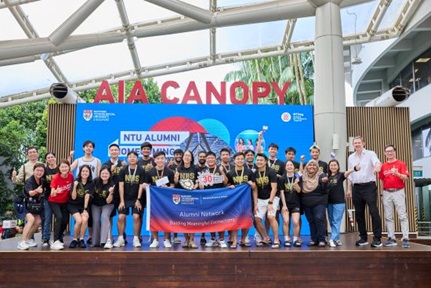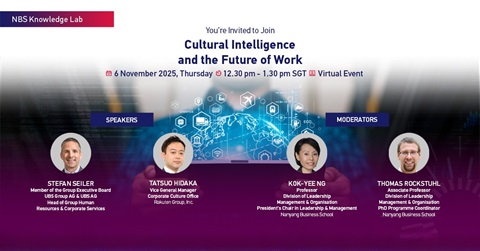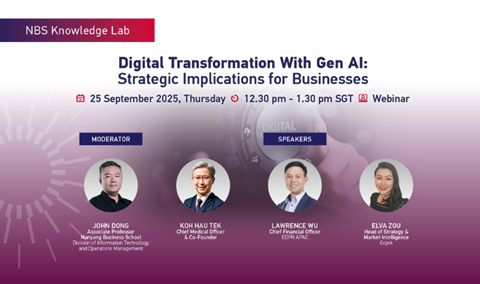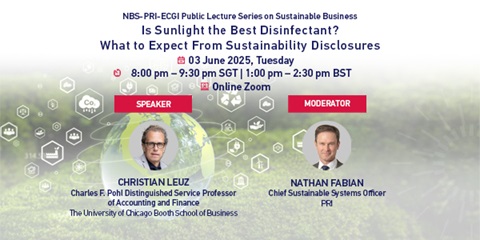NBS Knowledge Lab Webinar: Cryptocurrencies and Blockchain Technology: Where to Head Next?
In this webinar, our expert panellists discussed critical topics driving interest in the region and globally, including role of policymakers and regulators in the new crypto market, the recent advancements in blockchain security and infrastructure.
With the bankruptcy of crypto giants like FTX, Luna/Terra and Three Arrow Capital in 2022, cryptocurrency appears to be experiencing one of its worst times. However, even with negative news, blockchain technology continues to surge forward. How should and can the crypto market move forward in the current climate? In this edition of the NBS Knowledge Lab, our panellists address key questions on the structural issues in the crypto market and how to build an innovative and responsible digital asset ecosystem.
The panellists were: Mr Alan Lim, Head of the Fintech Infrastructure Office at the Monetary Authority of Singapore (MAS); Mr Chia Hock Lai, Board Chairman of Blockchain Association Singapore (BAS), a non-profit organisation set up to support the growth of the blockchain and digital asset sector in Singapore; and Ms Emma Cui, Founding Partner and CEO of LongHash Venutres, a Web3-focused accelerator and venture capital fund that is headquartered in Singapore. The session was moderated by Associate Professor Cindy Deng Xin, Nanyang Business School, NTU.
The following is an edited transcript, with some takeaways from the moderator:
Mr Alan Lim on the digital asset ecosystem in Singapore
In terms of the digital asset ecosystem, there are aspirations towards certain forms of crypto assets that are looking to be a form of medium of exchange and there are crypto assets that aim to represent real world financial assets or real economy assets. There are a set of crypto assets that aim to represent, for example, ownership of certain intellectual property. So, we see a variety of different forms of digital assets. The area that I think we would like to emphasise is this idea of digital assets that support use cases that ultimately lead to better economic potential and outcome for individuals as well as the economy at large.
One of the key elements of the digital asset ecosystem is the need for a medium of exchange. There have been four candidates that have been put forward. On one side, cryptocurrencies and the other side, central bank digital currencies. In the middle is a variety of options, whether it is secure, well-regulated, stable coins or tokenised bank liabilities or tokenised form of deposits by deposit-taking institutions. Looking across the spectrum, we need to consider if cryptocurrencies really serve effectively as a medium of exchange and a store of value in order to support economic activities. Our point of view is that it does not really do so. This is largely because the prices that have been assigned to some of these crypto assets are highly volatile and this is largely down to sentiments. So, it is very hard to predict whether prices are going up or down. Alternatively, stable coins take some attributes from the original crypto technology itself and apply that to the Fiat world. With the right set of measures, for example, the reserve assets backing the stable coin, this could potentially serve as a mechanism to support use cases such as cross border payments. Tokenised deposits is an area that we see increasing focus by commercial banks, with a slight difference in terms of characteristics. In central banks, digital currency is another element that we see potential to function as a medium of exchange.
The reason for bringing up these four candidates is because it is important to understand the use cases that we are looking at. A variety of central bankers around the world are investigating medium of exchange in order to support concept programmable money. We are taking the approach ourselves in Singapore. We are looking at the space not with the view that we need to issue a retail central bank digital currency but with the idea that if the future of financial networks is going to be based on digital assets, what is the right form of medium of exchange that would support that? Firstly, this idea of programmable money—how does it support use cases? Is it things like supporting government disbursements, commercial vouchers, supporting escrow commercial agreements to support the delivery of money for specific purpose, etc.?
The second bucket is this idea of cross border collaboration, which we are continuing to look into. Under Project Ubin, which we began in 2016, we have uncovered the possibility of use cases involving how interbank settlements could be performed more efficiently with a notion of atomic settlement. On a cross border basis, we have announced an initiative called Ubin+, which builds upon the efforts of Project Ubin, with the idea that there is potential for cross border collaboration on this notion of wholesale digital currency held by financial institutions. We are working on a number of different efforts with other central banks in Europe, in multilateral organizations (e.g., Swift) and others to sandbox and experiment.
The third bucket on digital assets or tokenisation, which is one of the key possibilities there is, aside from programmable money or this idea of defining purpose for how money is to be spent. The third piece is this idea of how assets could be settled instantaneously. It could be assigned such that it could support, for example, how assets are actually traded or it could be used as collateral for borrowing and lending activities. A large part of that innovation that is happening in this space is this notion of Development Finance Institution (DFI). If you look at DFI, a lot of the experimentations or what is happening in it has been driving a lot of velocity, a lot of innovation, a lot of changes. But on the flip side, you do not really know the developers behind it, you do not really know the roadmap behind it. You do not know whether, for example, the code base that has been released, even though it is open source, has been properly scanned. The controls and measures are in place such that the code that is advertised is in fact the code that is actually deployed. It is hard for an individual investor that has access to DFI protocols, for example, to really understand and know what they are actually participating in. Likewise, how much of the say in changes in some of these DFI protocols gets translated? How much of the individual vote gets translated? Not to mention existing risks such as code injection, etc. to the underlying smart contract itself.
With that as a framework, it opens up the possibility to take some of those lessons that we have learned from traditional finance, as well as some of the innovation that are coming up in this space, and really look at how we can enable through the possibility of some of the characteristics mentioned to support new forms of lead processes or, in fact, new financial products that did not deliver. One of the areas that MAS is investigating and spending a lot of time on more recently is this notion of tokenisation of financial assets and real economy assets. There are three elements: programmable money, cross border collaboration on atomic settlement, and asset tokenisation. Those are the key things that we are looking at from an innovation side. On the risk side, how do we address against emerging risks from those areas? For some existing securities, there are frameworks and regulations in place to support, which perhaps need to be relooked based on a new set of technologies. For other areas, there are regulations or perhaps guidelines that are pertinent for existing financial services, as well as new and emerging ones (e.g., anti-money laundering, technology and cyber risk, self-custodial wallets versus custodial wallets, the heightened need for individual to figure out how their keys are managed). Other areas that we are looking at is this idea of consumer awareness, and how we will increase the protection that we have to consumers or users that are getting into this space. Again, this is an evolving space and we continue to look at what measures to support it. Other areas include how we support well-regulated stable coins and the measures that we can take towards addressing or reviewing the possible impact on financial stability. Approaching the issue from the innovation and regulation side really come hand-in-hand in MAS’s approach.
Mr Chia Hock Lai on transparency and accountability
There are several ways to build a more transparent and accountable blockchain and crypto community. Firstly, it is definitely about actively engaging regulators. This is a rapidly evolving sector and both sides of the coin (i.e., the industry and the regulators) are constantly learning. In Singapore, MAS is very progressive and open minded about talking to the industry. For example, in November 2022, there were two consultation papers (on stable coin and more measures to protect investor interest in crypto), which MAS repeatedly engaged with industry associations in.
The second point is about industry associations staying united and self-regulating as responsible innovation on multiple fronts. For example, in the recent consultation paper, there was a call for customer knowledge or risk awareness test. This was something that we proposed early 2022 and I think this is something that the industry could agree on: what are the common questions that will be relevant and need to be incorporated in this risk awareness questions? Also, the presence of a code of practice is quite common in other countries. Those who follow the market in Singapore would know that in early 2022, MAS banned retail advertisement by crypto players. I think one way to address this could be a kind of industrial white-collar practice, which the crypto players could apply to, coupled with guidance from MAS, for the industry to self-regulate, again, because this is an evolving industry.
Thirdly, public education and active enforcement. There are three sub areas: (1) educating the public about the risks of cryptocurrency; many were affected by the FTX saga despite MAS warnings; (2) educating the public on the risks in engaging services from unregulated entities because if you transact on unregulated entity platforms, you will not have the protection that those who are licensed by MAS possess; and (3) having enforcement to non-compliant entities, especially unregulated entities. In Singapore, crypto players are regulated under the Payment Services Act. If we allow non-compliant entities to provide services to Singapore, it would not be fair to those who comply and are good corporate players. So, I think a lot more public education can be done both ground up and top down.
Last but not least, I think it is really about staying connected and updated to international regulatory development. My personal view is that I do not think there is a one-size-fits-all regulatory approach for crypto because even within ASEAN countries, Indonesia treats cryptocurrencies as commodities, Malaysia treats it as securities while Singapore treats it as payments. Even with debt, Indonesia is now moving from treating it as commodities to securities and, Singapore is, with recent consultation with MAS, considering pulling some security regulations into regulating crypto. Clearly, the space is really evolving very fast and Singapore needs to keep updated.
With respect to questions on competition from Hong Kong, I do not think that in terms of geographical location, we are really competing. The market is big and with more player activity coming into the space, more jurisdictions would become more open and progressive towards digital assets, which is good for the industry as a whole. The latest report I saw indicated that there were about 400 million crypto wallets created. Compare that to the eight billion in the world's population, that is just about 5%. This space still has a lot of potential to grow but, of course, it is not just about cryptocurrency. There are also stable coins, asset backed tokens, etc.
Ms Emma Cui on important factors for market participants
The headquarters of LongHash Ventures is based in Singapore but the firm invests across the globe. So, the projects do come from different geography and sometimes it is hard for a project to call one base home and to figure out which is the right regulatory framework. In addition, the products that we deal with are very early-stage projects and very sensitive. I think they do start to want to understand the regulatory framework for the incorporated companies. What we have observed is that they tend to migrate very easily to regulatory friendly jurisdictions, such as Dubai, Singapore, Hong Kong, etc. Singapore has benefitted from that overall trend as a lot of blockchain, crypto players have set up headquarters or regional headquarters here.
On the other hand, you want to protect the retailers. It can be quite hard to separate genuine innovation from scammers out there. How do you strike a balance? On one hand, regulators want to have a safe space for early-stage innovations to take place, for clients to feel that they are appreciated, without too many strings attached. On the other hand, how do you protect the retailers that might be serviced by some of those crypto players? I do think, over the years, the regulatory framework has made huge progress. Like in Singapore with the rollout of the Payment Service Act, we are thinking of incorporating more security laws over digital assets space, I think there is a dread of more granular regulations over this space. From market participants’ perspective, given that we deal with very early-stage projects, I think the hope for market participants is always a practical and transparent framework (i.e., not so much red tapes because startups do not have so much resource or funding like the big boys to be compliant from day one). How do you make sure you have a sandbox-safe environment for early-stage innovations to blossom and how do you regulate later stage players that are serving millions of users? I think the framework has to be a bit more nuanced.
Secondly, I think it is important for regulators to understand the technology because you cannot regulate something you do not understand. And the technology is moving so fast. If you know how to use the right analytics, you will actually have more tools on hand to separate good actors from bad actors. I think that is a really big thing for regulators to be aware of as well. Other than that, I think regulation always tends to swing from one side to the other side. At one point in time, it may feel over regulated and then regulators tend to adjust to a looser environment. I do think after what happened last year to FTX, perhaps a bit more stringent oversight is going to come onto the market.
Key takeaways
The regulation of cryptocurrency and broader digital asset in Singapore aims to address innovation, risk, consume awareness and financial stability. Digital asset ecosystem is very broad, including cryptocurrency, CBDC, and a variety of options in the middle such as well-regulated stablecoins and tokenized bank liability/deposit. In terms of innovation, MAS pays close attention to programmable money, cross boarder collaborations, and tokenization and institutional DeFi. On the risk side, there are regulations or guidelines for emerging risks arising from technology adoption, such as technology cyber risk, self-custodial wallets, and key management. Increasing user or consumer safety and ensuring financial stability are crucial in this evolving market.
With regard to the market in 2023, inflation is declining, and the overall economy is looking more promising than in 2022. There are also many technological upgrades to anticipate, such as Ethereum Shanghai update, which has the potential to substantially enhance the capabilities of blockchain technology. Additionally, in 2023, regulatory clarity will be increased.
Compared to the last bear market in 2017, when there was nothing to interact with except theoretical whitepapers, this round has many more applications, even if many of them are still in their early phases. According to our panellists, asset tokenization and UI/UX are important topics, and stablecoin may have mass adoption in 2023.
Watch the webinar here:







